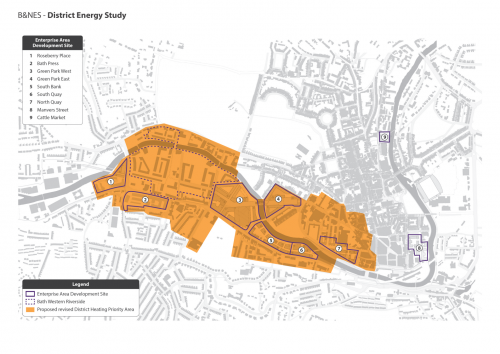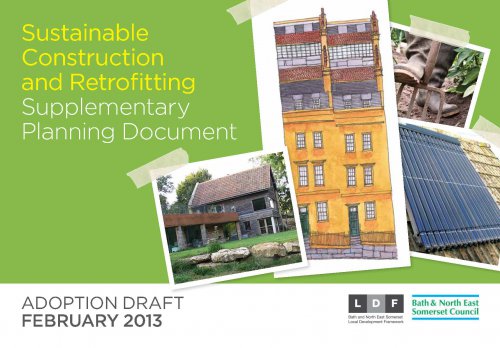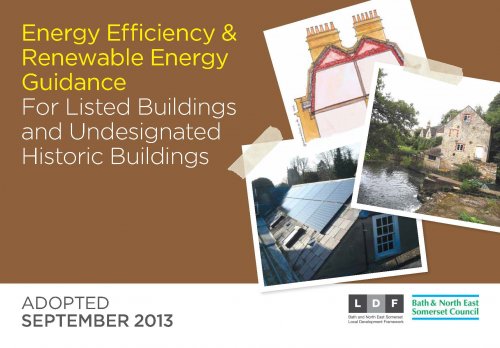Policy and Guidance Documents
Contents
1. Sustainable Construction Checklist Supplementary Planning Document (SPD) to be submitted as part of all proposals within the scope in order to register an application
Supporting documents:
2. Sustainable Construction Checklist SPD: Heat Networks Guidance Note to reference if the proposal is in a Heat Network Priority or Opportunity area
3. Sustainable Construction and Retrofitting Supplementary Planning Document (SPD) to review for locally-specific guidance on measures to meet the requirements of the Checklist SPD
4. Energy Efficiency & Renewable Energy for Listed Buildings and Undesignated Historic Buildings to review if the application is on a historic building
5. Informal Guidance Note: Renewable Energy in the Green Belt in Bath & North East Somerset for free-standing renewable energy applications
6. Sustainable Construction Policy: Evidence documents Background information; the evidence upon which policies are based and some case studies
7. Future Homes Standard Consultation: The West of England Local Authorities evidence
Tackling climate change is a key priority for Bath and North East Somerset Council, and it is recognised that buildings which minimise carbon emissions and are resilient to the future climate can also provide greater occupant comfort and lower energy costs.
Click here for guidance on how to make your home more energy efficient
The adopted Placemaking Plan has a cross cutting objective to pursue a low carbon and sustainable future. A suite of policies to implement this objective can be found in the “Responding to Climate Change” section. Applicants are advised to review the Placemaking Plan Climate Change policies in full since other policies may also apply to their application. The documents below support applicants in meeting (and ideally exceeding) the planning requirements set out in this section of the Placemaking Plan.
Last updated: 19th November 2019
1. Sustainable Construction Checklist Supplementary Planning Document (SPD) (Downloadable Checklist)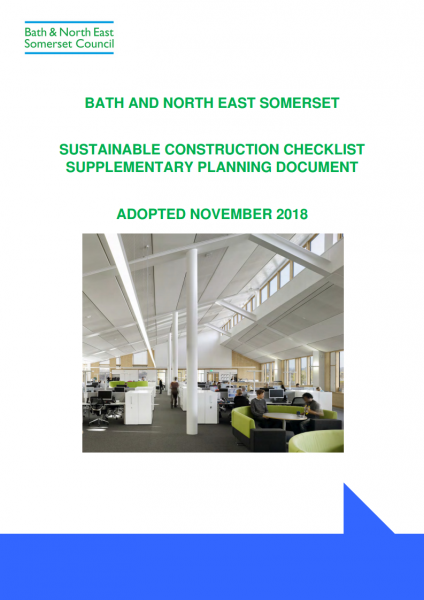
In order to register a planning application, applications for the development types below will need to complete and attach the Checklist and any supporting documentation that it requires:
- All new build proposals
- All medium scale proposals or larger for works on existing buildings (5+ dwellings or 500m2 + of floor space)
Householder applications are exempt. The first section of the SPD is detailed guidance on how to complete the Checklist itself. Please see this section for the requirements for different application scales, types and stages e.g. Outline, Full, Condition Discharge.
Please note- Version 2 of the Checklist (2020), as found on this page, should now be used for all applications. The requirements and methodologies have not changed, however this version contains minor clarifications and revisions based on feedback from applicants and officers.
This SPD was adopted in November 2018 following a public consultation. Below is a summary of the responses to the consultation and the adoption statement.
2. Sustainable Construction Checklist SPD: Heat Networks Guidance Note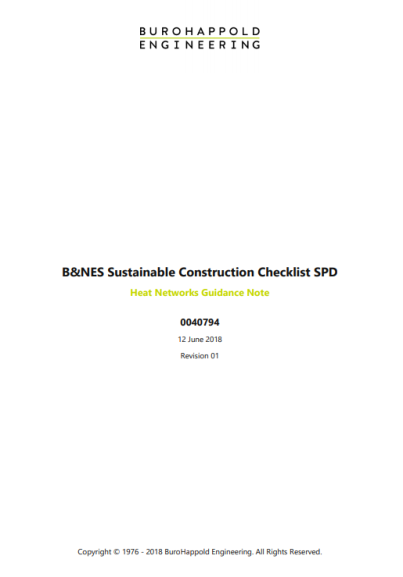
Proposals within the Heat Network Priority or Opportunity Areas can refer to this detailed guidance on how to respond to the requirements in the District Heating section of the SPD above. The Note sets out how to future proof for heat networks and summarises the Council’s studies on how heat networks might come forward in the Priority Areas.
To see if your proposal is in a Heat Network Priority Area please see the Council’s mapping tool; click on the “planning” tab then “planning constraints” to find the district heating layers. The maps below replace the “yellow circles” showing Heat Network Priority Areas in the Placemaking Plan (p72 and 73). The yellow circles representing Heat Network Opportunity Areas in the Placemaking Plan can still be used.
Bath Heat Network Priority Area
Keynsham Heat Network Priority Area
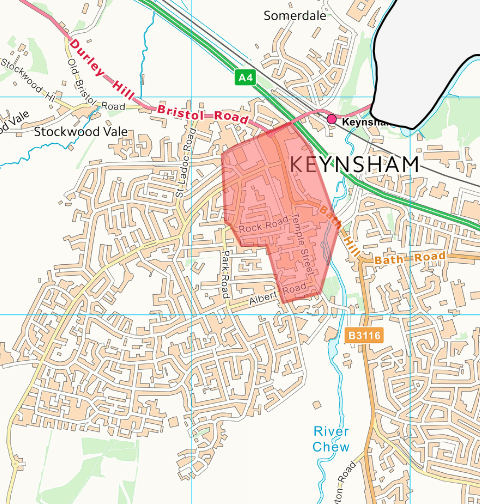
3. Sustainable Construction & Retrofitting SPD
- 9 Sustainable construction principles to help you green any new build project
- Explanation of how the 5 main house types in the area are built
- Introduces 24 retrofit options from energy and water efficiency to heating and domestic renewable energy
- What planning, building control & listed building permissions you may need
- Local case studies and diagrams, photographs and sketches
4. Energy Efficiency & Renewable Energy Guidance For Listed Buildings and Undesignated Historic Buildings
This Guidance is intended to provide general advice to owners of historic buildings, developers, architects, surveyors and anyone proposing measures to improve energy efficiency or domestic scale renewable energy of designated and undesignated heritage assets.
Applicants can also refer to the Sustainable Traditional Buildings Association (STBA) Responsible Retrofit Guidance Wheel for further advice on preparing an application.
5. Informal Guidance Note: Renewable Energy in the Green Belt in Bath & North East Somerset
Drawing on national and local planning policy, this document provides informal guidance on how renewable energy planning proposals should respond specifically to the Green Belt designation.
6. Sustainable Construction Policy: Evidence documents
Zero carbon buildings
Joint Spatial Plan Strategic Development Locations: Routes to Zero Carbon (Regen SW, 2019)
The process is now underway to refresh the Placemaking Plan and review the climate change policies. This study is a high-level analysis of the carbon reductions possible on the Strategic Development Locations proposed across the West of England, to inform the next round of policy making.
Renewable Energy
Renewable Energy and Planning Research – Update (Camco, 2010)
This study underpins Placemaking Plan Policy CP3: Renewable Energy. It assesses renewable energy resources in the district.
This report is a landscape sensitivity analysis in relation to wind energy development, to inform policy within B&NES.
Heat Networks/ District Heating
District Heating at Bath Riverside Enterprise Area (Buro Happold 2015)
This is the evidence underpinning the Bath Heat Network Priority Area
District Heating in Keynsham (Buro Happold 2015)
This is the evidence underpinning the Keynsham Heat Network Priority Area
Case Studies
Keynsham Civic Centre will be amongst the most energy-efficient Council offices in the country, with one of the largest council-owned solar panel systems in the UK. The 750 solar panels – which cover an area equivalent to more than four tennis courts – will generate over 230,000 units of electricity each year, equivalent to the annual energy use of almost 70 homes. This will benefit the Council by around £50,000 every year, and reduce annual CO2 emissions by 125 tonnes. Over 20 years the benefits are expected to reach almost £1.5 million, and avoid CO2 emissions of 2,355 tonnes. This case study highlights its features and achievements. The Keynsham Civic Centre was designed to achieve a Display Energy Certificate rating of “A” and has won numerous awards for sustainability. Notably, through attention to design, the exemplary energy performance was achieved at no capital cost uplift.
Ralph Allen Yard demonstrates accomplished sustainable construction, reaching Code for Sustainable Homes level 5. The brownfield site was transformed into a sustainable and community orientated development. This case study highlights its features and achievements.
7. Sustainable Construction Policy: West of England Local Authorities evidence
The West of England Local Authorities commissioned evidence to support a response to the Future Homes Standard consultation which closes 10th January 2020. Key findings are as follows:
1. The proposed national trajectory for reducing CO2 emissions at 2020 and 2025 does not reduce emissions as much as the draft zero-carbon WoE policies. The WoE policies, which intend to cover unregulated as well as regulated emissions, would save around 200,588 tCO2 (41%) between by 2030. If only regulated emissions were covered by the policies, this would be 109,930 tCO2 (23%) by 2030. Annual saved emissions would increase each year as new dwellings are built.
2. The proposed 2020 standard (Option 2) could allow worse fabric than is currently allowed under Part L 2013, since the FHS consultation proposes to remove the FEES requirement. Modelling the minimum fabric standards proposed for the 2020 standard resulted in the modelled dwellings failing the Part L 2013 Fees target by 46% (semi-detached house) and 51% (mid-floor flat), while meeting the proposed Part L 2020 requirements, through the use of heat pumps.

